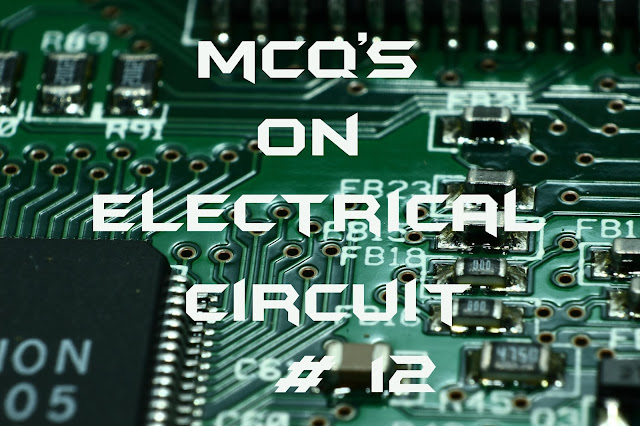Hi friends, these are some of the multiple choice questions on electrical circuits. These are some of the basic questions which are asked in previous competitive papers check out and comment...
1) What is a closed path made of several branches of the network called?
A) Junction
B) Node
C) Terminal
D) Loop
Ans:D
2) The internal resistance of an ideal voltage source is
A) Infinite
B) Equal to the load resistance
C) Zero
D) To be determined
Ans:C
3) What is the conductance of a circuit having three 10 Ω resistors in parallel?
A) 0.3 S
B) 3.33 S
C) 0.33 S
D) 30 S
Ans:A
4) Electric energy refers to
A) Volt divided by coulomb
B) Volt-ampere
C) Volt-coulomb
D) Watt divided by time
Ans:C
5) A capacitor requires 12 µC of charge to raise its potential of 3 V. What is the capacitance of the capacitor?
A) 36 µF
B) 15 µF
C) 0.25 µF
D) 4 µF
Ans:D
6) A capacitor opposes change in
A) Voltage
B) Current
C) Voltage and current
D) Neither voltage nor current
Ans:A
7) What is the total resistance of a two equal valued resistors in series?
A) The difference of both
B) The product of both
C) Twice as one
D) The sum of their reciprocals
Ans:C
8) The ratio of maximum value to the effective value of an alternating quantity is called
A) Form factor
B) Peak factor
C) Dynamic factor
D) Leakage factor
Ans:B
9) For series capacitors, total charge is
A) The sum of individual charges
B) Equal to the charge of either capacitors
C) Equal to the product of the charges
D) The quotient of the charges
Ans:B
10) Series resonant circuit is sometimes known as
A) Rejector circuit
B) Acceptor circuit
C) Inductive circuit
D) Capacitive circuit
Ans:B
If you like my post please share it with your friends and subscribe to latest updates.. If you have doubts you can start new topic on forum and start discussion with our readers..
1) What is a closed path made of several branches of the network called?
A) Junction
B) Node
C) Terminal
D) Loop
Ans:D
2) The internal resistance of an ideal voltage source is
A) Infinite
B) Equal to the load resistance
C) Zero
D) To be determined
Ans:C
3) What is the conductance of a circuit having three 10 Ω resistors in parallel?
A) 0.3 S
B) 3.33 S
C) 0.33 S
D) 30 S
Ans:A
4) Electric energy refers to
A) Volt divided by coulomb
B) Volt-ampere
C) Volt-coulomb
D) Watt divided by time
Ans:C
5) A capacitor requires 12 µC of charge to raise its potential of 3 V. What is the capacitance of the capacitor?
A) 36 µF
B) 15 µF
C) 0.25 µF
D) 4 µF
Ans:D
6) A capacitor opposes change in
A) Voltage
B) Current
C) Voltage and current
D) Neither voltage nor current
Ans:A
7) What is the total resistance of a two equal valued resistors in series?
A) The difference of both
B) The product of both
C) Twice as one
D) The sum of their reciprocals
Ans:C
8) The ratio of maximum value to the effective value of an alternating quantity is called
A) Form factor
B) Peak factor
C) Dynamic factor
D) Leakage factor
Ans:B
9) For series capacitors, total charge is
A) The sum of individual charges
B) Equal to the charge of either capacitors
C) Equal to the product of the charges
D) The quotient of the charges
Ans:B
10) Series resonant circuit is sometimes known as
A) Rejector circuit
B) Acceptor circuit
C) Inductive circuit
D) Capacitive circuit
If you like my post please share it with your friends and subscribe to latest updates.. If you have doubts you can start new topic on forum and start discussion with our readers..

EmoticonEmoticon